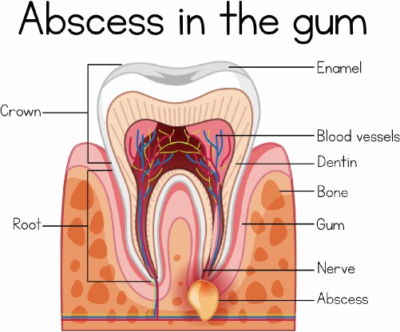Have you ever experienced pain in your neck and ear for no reason? Have you visited your dentist in last 6 months? If the answer is no then you should schedule your appointment with the dentist right away. Have your teeth checked for cavities or any abscess that sometimes radiates pain to ear and neck.
 WHAT IS AN ABSCESSED TOOTH?
WHAT IS AN ABSCESSED TOOTH?
An abscessed is a infection forming in any region of a tooth, jaw and gums due to bacterial infection. It is also called a dental abscess that causes moderate to severe pain. It is very important to treat these abscesses because a tooth containing abscess can lead to some life-threatening problems. Some of the common tooth abscesses are a periapical abscess, periodontal abscess and gingival abscess.
WHAT ARE THE SYMPTOMS?
One of the main symptoms of an abscessed tooth is throbbing pain in your gums and near tooth. The pain usually occurs suddenly and gets worse with time. Other symptoms you might notice are pain in your ear, neck or jaw that radiates due to an abscessed tooth, feeling a throbbing pain when you lie down, difficulty while chewing and biting, inflamed red-colored gums, halitosis, inflamed lymph nodes, and fever.
Remember If you feel immediate pain relief after a throbbing pain it means that the abscess has ruptured. There are chances that You will notice an abrupt bad taste in your mouth as the pus comes out.
WHY TOOTH ABSCESS OCCURS?
There are multiple causes of an abscessed such as when Bacteria get into your teeth or gums it will lead to a dental abscess. However, there are numerous ways this can happen, and It also depends on the type of abscess:
– Periapical abscess: In such kind of abscess the Bacteria pass in the pulp of your teeth, usually through a dental decay or cavity. The soft inner and alive part of your tooth is referred to as pulp. It contains nerves, connective tissue, and blood vessels.
– Periodontal abscess: Gum diseases are usually involved in the formation of this type of abscess, but it can also be due to an injury to tooth or gums.
– Gingival abscess – it occurs due to irritation of the gums for example when food or any foreign body gets embedded in your gums it will ultimately gingival abscess.
WHAT ARE THE TREATMENT OPTIONS?
The main purpose of Treating an abscessed tooth is to focus on clearing up the infection and releasing pain. When you will visit a dentist he might start your treatment with a dental X-ray according to the severity. An x-ray will help the dentist to see whether the infection has gone to other areas or not.
The treatment options include:
– When the abscess is visible the dentist will make a small cut in the region to drain the pus.
– When the abscess occurs due to a cavity in the tooth then root canal procedure is advised. It involves drilling into the decayed tooth to drain the pus and remove the infected pulp then your dentist will fill and seal the pulp chamber.
– If the tooth is too damaged, your dentist might extract it before removing the abscess.
– The infection has spread in other areas or you have a low immune system. Antibiotics will be prescribed by the dentist to clean the infection.
– If the abscess is due to gum infection Removal of calculus or irritant that dentist will remove it and clean with saltwater.
An abscessed tooth should settle within a couple of weeks after the treatment. Even if you notice that it is still draining on its own, it’s vital to visit your dentist to verify that the infection doesn’t spread to another part. To reduce the risk of an abscessed tooth you should practice good oral hygiene and visit your dentist every 6 months, this will help you to maintain good oral health as well as overall health.



